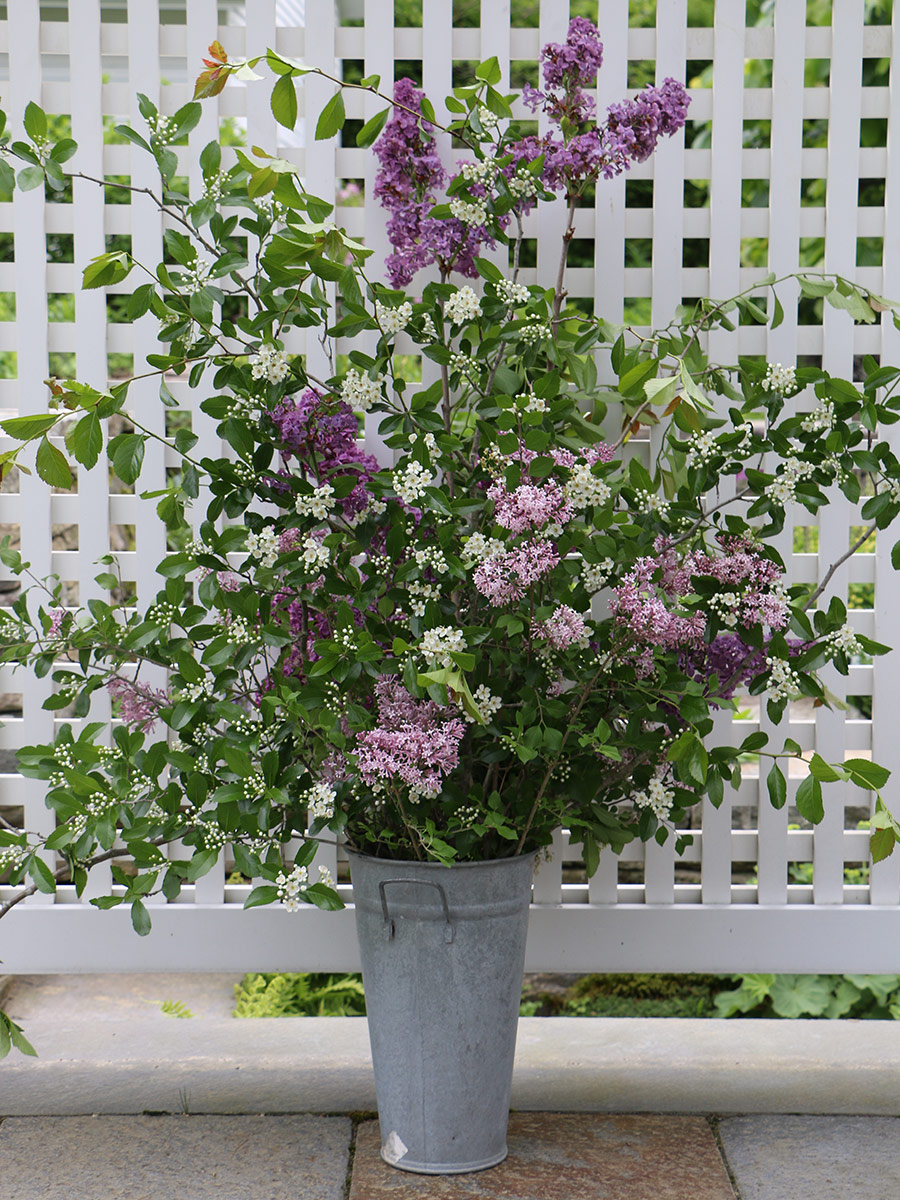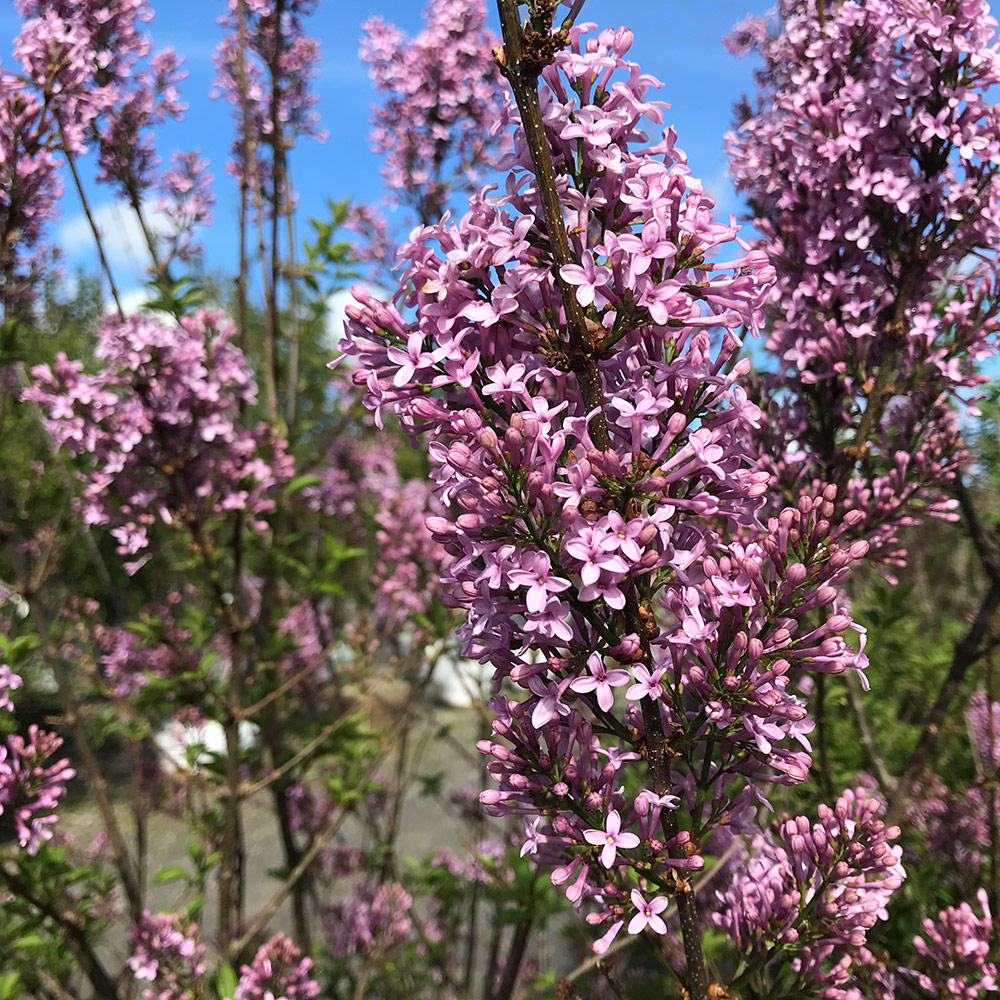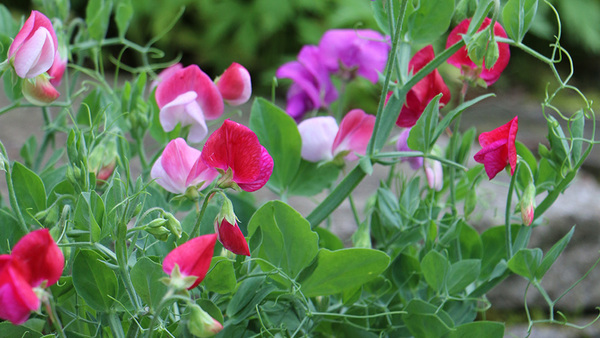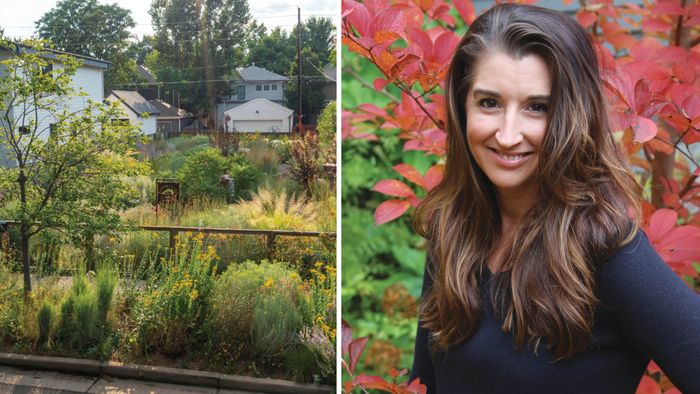
Lilacs (Syringa spp. and cvs., Zones 3–8) are so commonplace in many parts of North America that it may surprise you to learn that they are not native to this continent. Of the 20 to 25 species of lilacs, all come from Europe and Asia. While not native to North America, lilacs were fragrant imports that arrived around the same time as the colonists. Today, lilacs are one of the first plants young families choose to grow when they get their first homes.
Although deliciously fragrant and beautiful when in bloom, lilacs rarely make excellent specimen plants and are best if located somewhere they can grow tall. They can (and should) be picked as cut flowers. They are not well suited for use as hedges or clipped shrubs. Lilacs are stunningly beautiful when in bloom anytime from April to June, (although newer addition to the market, the Bloomerang® series, promises shrubs will rebloom into August) but it is the unmistakable scent of the blossoms that is behind much of their appeal.

How to plant new lilacs
Lilacs are best grown in an area of the garden that can handle their casual forms. Often they are included in a loose hedgerow of shrubs or set along the boundary of a yard. A well-grown lilac naturally looks untidy.
Planting a young lilac couldn’t be easier. There are plenty of varieties available today, both old and new. As with many plants, the more modern strains tend to be more vigorous and disease resistant. Resist buying value plants from mail-order sources that promise a bareroot lilac shrub for just a few dollars. These may take years to establish themselves, and even when they do, the results are often not satisfactory.
Starting with a nursery-bought 1- to 5-gallon container is best. Prepare a hole with soil that is slightly acidic to alkaline—lilacs love slightly alkaline soil of around 7 pH. A little horticultural powdered lime will make soil more alkaline if your soil tends to be acidic. Lilacs also dislike drought and do best with about an inch of water a week. Remember, they form their flower buds in late summer, often when droughts are at their peak, so additional irrigation is helpful. Most lilacs prefer full sun.

How to prune lilacs
Lilacs are loosely growing shrubs, and while long-lived, they do need some annual maintenance if you want the best possible blooms. Remove one-third of the old trunks once a shrub has matured and has woody, bark-covered trunks. Lilacs bloom best on newer branches, usually ones that rise from the base and are two to three years old. Old, mature wood will form small, thin limbs, and while flower buds will still form, the weight of the flowers is often too much for the spindly stems, and the flower heads will be much smaller.
Removing old woody stems from mature plants is best done after the flowers have faded, usually in late June. This will give the plants time for new stems to emerge from the base of the shrubs. By removing one-third every year, you will continue to get some bloom every year. Some older shrubs may benefit from complete removal of all large stems at once, but that may prevent blooming for a couple of years until growth is mature again.
Regenerating old lilacs
Pruning is critical with old lilacs, and while many choose to prune an ancient, woody lilac in early spring, this is the wrong time. Prune an old lilac just after it blooms. Either remove all the dead and mature growth down to the ground, leaving 10-inch-long stumps, or cut limbs with a saw, removing about one-third of the old growth each year until the entire shrub is regenerated. Amend the soil with a balanced 10-10-10 fertilizer or manure, and add plenty of ground limestone to the surface. Keep an eye on watering as well, applying an inch of water a week as a good target. Expect new growth to bloom in the second year after pruning. For more on pruning lilacs, check out How to Prune Lilacs.
Watch out for disease
Lilacs are prone to powdery mildew damage, which can be controlled with copper-based sprays. Often this affliction doesn’t harm flower buds, as it appears in mid to late summer. Powdery mildew typically appears as a white, powdery substance on the surface of the leaves. Proper pruning to thin shrubs and providing a breezy site will help.
Lilac species and hybrids
There are many lilac varieties and hybrids to choose from, but if you are seeking pure lilac fragrance, look for varieties of common lilac (Syringa vulgaris, Zones 3–7) or Syringa × hyacinthiflora (Zones 3–7), which is a hybrid made from common lilac and early lilac (Syringa oblata, Zones 3–6). Syringa × hyacinthiflora varieties are also known to be early blooming. Other species, such as Korean lilac (Syringa meyeri, Zones 3–7), may be highly scented, but the fragrance is nothing you’d identify as lilac. Korean lilac and some other species have strong scents of jasmine or spicy viburnum, which is still lovely but may be disappointing if you’re expecting that classic lilac scent. In addition to fragrance, color and form vary among lilacs and should be taken into account.
Favorite lilac varieties
Here are a few tried-and-true cultivars that will wow you with their colorful blooms and rich fragrance.

‘Miss Kim’ Manchurian lilac
Syringa pubescens subsp. patula ‘Miss Kim’, Zones 3–8
This popular Manchurian or Korean lilac is commonly found in nurseries. It’s strongly fragrant with a spicy viburnum scent that is reminiscent of cloves and cinnamon.

‘Charles Joly’ lilac
Syringa vulgaris ‘Charles Joly’, Zones 3–7
This is a true antique variety from the 1800s. It matures into a multistemmed shrub with single dark purple-plum blooms and a classic lilac fragrance.

‘Marie Frances’ lilac
Syringa vulgaris ‘Marie Frances’, Zones 3–7
With strongly scented pale-pink blossoms, ‘Marie Frances’ has long been a favorite. The pink coloring is unique and blends well with both purple and white lilacs.

New Age™ White lilac
Syringa vulgaris ‘G13103’, Zones 4–7
A newcomer to the lilac scene, this vivid-white lilac has much to offer. Maturing at only 4 to 5 feet tall, it’s also more mildew resistant than older varieties.

‘Sensation’ lilac
Syringa vulgaris ‘Sensation’, Zones 3–7
If there was a lilac popularity contest, this beauty could win hands-down. Its star appeal comes from its large, magenta-violet florets, which display a distinct outline of contrasting white around the edges of the petals.

Bloomerang® lilacs
The newest lilacs on the scene are sometimes listed as “ever blooming,” and they do indeed bloom multiple times from spring to autumn. They include the popular series Bloomerang®, which comes in different colors. These are some of the most popular lilacs sold today.
Whichever of these lilacs you choose, be sure to provide the right conditions and maintenance to keep the abundance of fragrant blossoms coming every spring. For more information on lilacs, check out Lilacs: Time for a Fresh Look.
And for more Northeast regional reports, click here.
—Matt Mattus is the author of two books: Mastering the Art of Flower Gardening and Mastering the Art of Vegetable Gardening. He lives and gardens in Worcester, Massachusetts.
Photos: Matt Mattus
Fine Gardening Recommended Products

Berry & Bird Rabbiting Spade, Trenching Shovel
Fine Gardening receives a commission for items purchased through links on this site, including Amazon Associates and other affiliate advertising programs.

Lee Valley Mini Garden Shear Set
Fine Gardening receives a commission for items purchased through links on this site, including Amazon Associates and other affiliate advertising programs.

DeWalt Variable-Speed Cordless Reciprocating Saw
Fine Gardening receives a commission for items purchased through links on this site, including Amazon Associates and other affiliate advertising programs.
- 18.31 x 6.13 x 4 inches
- 1-1/8-inch stroke length
- Variable speed trigger with 0-3000 spm



















Comments
Log in or create an account to post a comment.
Sign up Log in